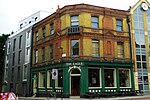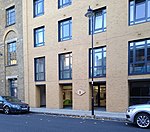London Post Office Railway
1927 establishments in England2003 disestablishments in England2 ft gauge railways in EnglandElectric railways in the United KingdomHistory of rail transport in London ... and 10 more
Industrial railways in EnglandLondon Post Office RailwayPostal history of the United KingdomPostal infrastructure in the United KingdomRailway lines closed in 2003Railway lines opened in 1927Subterranean LondonTunnels completed in 1927Tunnels in LondonUnderground railways in the United Kingdom

The Post Office Railway, is a 2 ft (610 mm) narrow gauge, driverless underground railway in London that was built by the Post Office with assistance from the Underground Electric Railways Company of London, to transport mail between sorting offices. Inspired by the Chicago Tunnel Company, it opened in 1927 and operated for 76 years until it closed in 2003. A museum within the former railway was opened in September 2017.
Excerpt from the Wikipedia article London Post Office Railway (License: CC BY-SA 3.0, Authors, Images).London Post Office Railway
Calthorpe Street, London Clerkenwell (London Borough of Islington)
Geographical coordinates (GPS) Address Nearby Places Show on map
Geographical coordinates (GPS)
| Latitude | Longitude |
|---|---|
| N 51.524 ° | E -0.1126 ° |
Address
London Central Mail Centre (Mount Pleasant Mail Centre)
Calthorpe Street
WC1X 9HX London, Clerkenwell (London Borough of Islington)
England, United Kingdom
Open on Google Maps










